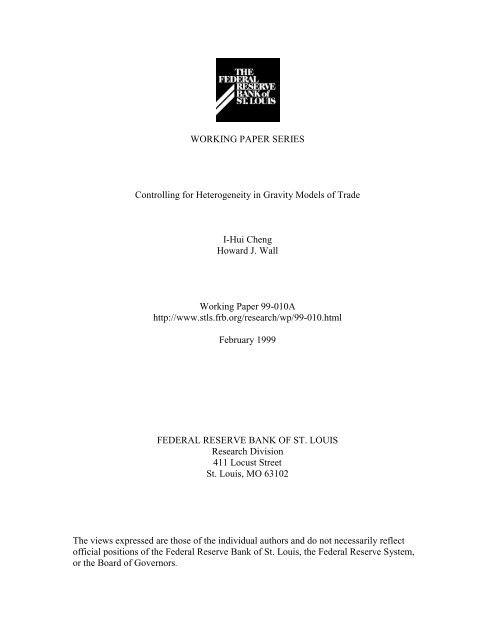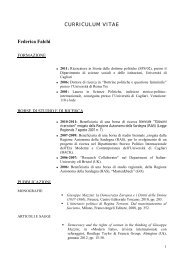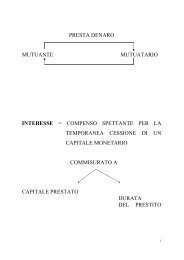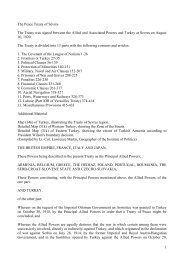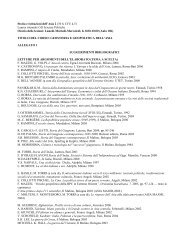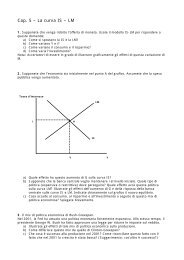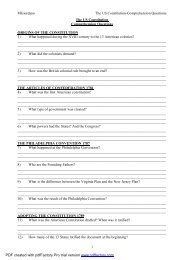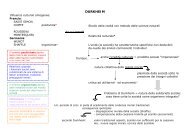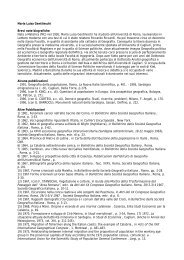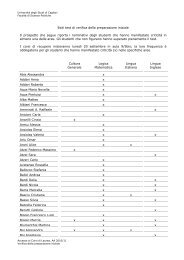Controlling for Heterogeneity in Gravity Models of Trade
Controlling for Heterogeneity in Gravity Models of Trade
Controlling for Heterogeneity in Gravity Models of Trade
You also want an ePaper? Increase the reach of your titles
YUMPU automatically turns print PDFs into web optimized ePapers that Google loves.
WORKING PAPER SERIES<strong>Controll<strong>in</strong>g</strong> <strong>for</strong> <strong>Heterogeneity</strong> <strong>in</strong> <strong>Gravity</strong> <strong>Models</strong> <strong>of</strong> <strong>Trade</strong>I-Hui ChengHoward J. WallWork<strong>in</strong>g Paper 99-010Ahttp://www.stls.frb.org/research/wp/99-010.htmlFebruary 1999FEDERAL RESERVE BANK OF ST. LOUISResearch Division411 Locust StreetSt. Louis, MO 63102The views expressed are those <strong>of</strong> the <strong>in</strong>dividual authors and do not necessarily reflect<strong>of</strong>ficial positions <strong>of</strong> the Federal Reserve Bank <strong>of</strong> St. Louis, the Federal Reserve System,or the Board <strong>of</strong> Governors.
<strong>Controll<strong>in</strong>g</strong> <strong>for</strong> <strong>Heterogeneity</strong> <strong>in</strong> <strong>Gravity</strong> <strong>Models</strong> <strong>of</strong> <strong>Trade</strong>I-Hui ChengBirkbeck College, University <strong>of</strong> LondonHoward J. WallFederal Reserve Bank <strong>of</strong> St. LouisFebruary 1999This paper argues that it is necessary to allow <strong>for</strong> country-pair heterogeneity when us<strong>in</strong>g thegravity model to estimate <strong>in</strong>ternational trade flows. We propose and estimate a fixed-effectsmodel that elim<strong>in</strong>ates the heterogeneity bias <strong>in</strong>herent <strong>in</strong> standard methods. Further, we show thatthere is no statistical support <strong>for</strong> the restrictions necessary to obta<strong>in</strong> exist<strong>in</strong>g empirical models,which are special cases <strong>of</strong> our model. Because the gravity model has become the ‘workhorse’basel<strong>in</strong>e model <strong>for</strong> estimat<strong>in</strong>g the effects <strong>of</strong> <strong>in</strong>ternational <strong>in</strong>tegration, this has important empiricalimplications. In particular, our results suggest that standard gravity estimates <strong>of</strong> the effects <strong>of</strong><strong>in</strong>tegration can differ a great deal from what is obta<strong>in</strong>ed when heterogeneity is accounted <strong>for</strong>.(JEL F15, F17)Correspond<strong>in</strong>g author: Howard J. Wall, Research Division, Federal Reserve Bank <strong>of</strong> St.Louis, P.O. Box 442, St. Louis, MO 63166-0442, United StatesE-mail: wall@stls.frb.org; Phone: (314)444-8533; Fax: (314)444-8731We would like to thank Ron Smith <strong>for</strong> his <strong>in</strong>sightful and helpful suggestions. We are alsograteful <strong>for</strong> comments from the participants at the Midwest International Economics Conferenceat Purdue University, May 1999. The views expressed are those <strong>of</strong> the authors and do notnecessarily represent <strong>of</strong>ficial positions <strong>of</strong> the Federal Reserve Bank <strong>of</strong> St. Louis, nor <strong>of</strong> theFederal Reserve System.
<strong>Controll<strong>in</strong>g</strong> <strong>for</strong> <strong>Heterogeneity</strong> <strong>in</strong> <strong>Gravity</strong> <strong>Models</strong> <strong>of</strong> <strong>Trade</strong>I-Hui Cheng and Howard J. Wall1. IntroductionStart<strong>in</strong>g <strong>in</strong> the 1860s when H. Carey first applied Newtonian Physics to the study <strong>of</strong>human behavior, the so-called “gravity equation” has been widely used <strong>in</strong> the social sciences.More recently, gravity model studies have achieved empirical success <strong>in</strong> expla<strong>in</strong><strong>in</strong>g various types<strong>of</strong> <strong>in</strong>ter-regional and <strong>in</strong>ternational flows, <strong>in</strong>clud<strong>in</strong>g labor migration, commut<strong>in</strong>g, customers,hospital patients, and <strong>in</strong>ternational trade. 1 The widespread use <strong>of</strong> gravity equations is despite thefact that they have tended to lack strong theoretical bases.The gravity model <strong>of</strong> <strong>in</strong>ternational trade was developed <strong>in</strong>dependently by T<strong>in</strong>bergen(1962) and Pöyhönen (1963). In its basic <strong>for</strong>m, the amount <strong>of</strong> trade between two countries isassumed to be <strong>in</strong>creas<strong>in</strong>g <strong>in</strong> their sizes, as measured by their national <strong>in</strong>comes, and decreas<strong>in</strong>g <strong>in</strong>the cost <strong>of</strong> transport between them, as measured by the distance between their economic centers. 2Follow<strong>in</strong>g this work, L<strong>in</strong>nemann (1966) <strong>in</strong>cluded population as an additional measure <strong>of</strong> countrysize, employ<strong>in</strong>g what we will call the augmented gravity model. 3It is also common to <strong>in</strong>steadspecify the augmented model us<strong>in</strong>g per capita <strong>in</strong>come, which captures the same effects. 4Whichever specification <strong>of</strong> the augmented model is used, the purpose is to allow <strong>for</strong> non-1 See Sen and Smith (1995) <strong>for</strong> a survey.2 For recent examples <strong>of</strong> the basic gravity model see McCallum (1995), Helliwell (1996), and Boisso andFerrant<strong>in</strong>o (1997).3 For recent uses <strong>of</strong> the augmented gravity model with population see Oguledo and MacPhee (1994), Boisso andFerrant<strong>in</strong>o (1997), and Bayoumi and Eichengreen (1997).4 Examples <strong>of</strong> the augmented model with per capita <strong>in</strong>come <strong>in</strong>clude Sanso, Cuairan, and Sanz (1993), Frankeland Wei (1998), Frankel, Ste<strong>in</strong>, and Wei (1995,1998), Eichengreen and Irw<strong>in</strong> (1998).1
homothetic preferences <strong>in</strong> the import<strong>in</strong>g country, and to proxy <strong>for</strong> the capital/labor ratio <strong>in</strong> theexport<strong>in</strong>g country (Bergstrand, 1989).The gravity model has been used widely as a basel<strong>in</strong>e model <strong>for</strong> estimat<strong>in</strong>g the impact <strong>of</strong>a variety <strong>of</strong> policy issues, such as regional trad<strong>in</strong>g groups, political blocs, patent rights, andvarious trade distortions. 5Typically, these events and policies are modeled as deviations fromthe volume <strong>of</strong> trade predicted by the basel<strong>in</strong>e gravity model, and, <strong>in</strong> the case <strong>of</strong> regional<strong>in</strong>tegration, are captured by dummy variables. The recent popularity <strong>of</strong> the gravity model ishighlighted by Eichengreen and Irw<strong>in</strong> (1997, p.33) who call the it the “workhorse <strong>of</strong> empiricalstudies <strong>of</strong> (regional <strong>in</strong>tegration) to the virtual exclusion <strong>of</strong> other approaches.” This is despite thefact that, as Deardorff (1984) po<strong>in</strong>ts out, most early papers were ad hoc rather than be<strong>in</strong>g basedon theoretical foundations. Exceptions to this <strong>in</strong>clude Anderson (1979), Bergstrand (1985),Hummels and Lev<strong>in</strong>sohn (1995), Deardorff (1998), and Feenstra, Markusen, and Rose (1998),whose models are consistent with the gravity model. See also Evenett and Keller (1998) who,along with Deardorff (1998), evaluate the usefulness <strong>of</strong> gravity models <strong>in</strong> test<strong>in</strong>g alternativetheoretical models <strong>of</strong> trade. The recent flurry <strong>of</strong> theoretical work has led Frankel (1998, p.2) tosay that the gravity equation has “gone from an embarrassment <strong>of</strong> poverty <strong>of</strong> theoreticalfoundations to an embarrassment <strong>of</strong> riches.”The perceived empirical success <strong>of</strong> the gravity model has come without a great deal <strong>of</strong>analysis regard<strong>in</strong>g its econometric properties, as its empirical power has usually been stated5 See Aitken (1973), Brada and Mendez (1983), Bikker (1987), Sanso, Cuairan, and Sanz (1993), Oguledo andMacPhee (1994), McCallum (1995), Helliwell (1996), Wei and Frankel (1997), Bayoumi and Eichengreen(1997), Mátyás (1997), Frankel and Wei (1998), Frankel, Ste<strong>in</strong>, and Wei (1998), and Smith (1999).2
simply on the basis <strong>of</strong> goodness <strong>of</strong> fit; i.e. a relatively high2R . 6The lack <strong>of</strong> attention paid to theempirical properties <strong>of</strong> the model is despite the fact that the strength <strong>of</strong> any basel<strong>in</strong>e model lies <strong>in</strong>the accuracy <strong>of</strong> its estimates. The aim <strong>of</strong> this paper is to beg<strong>in</strong> to fill the gap regard<strong>in</strong>g theempirical estimation <strong>of</strong> gravity models <strong>of</strong> trade. In particular, we demonstrate that standardmethods <strong>for</strong> estimat<strong>in</strong>g the gravity model produce biased estimates, tend<strong>in</strong>g to overestimate tradebetween low-trade countries, and to underestimate it between high-trade countries. We arguethat the primary source <strong>of</strong> this bias is the failure <strong>of</strong> standard methods to account <strong>for</strong> the pairwiseheterogeneity <strong>of</strong> bilateral trade relationships.The solution we propose uses simple panel data methods to allow <strong>for</strong> the <strong>in</strong>tercepts <strong>of</strong> thegravity equation to be specific to each trad<strong>in</strong>g pair. We demonstrate how with this empiricalmodel the correlation between the residuals and the volume <strong>of</strong> trade disappears. To illustrate theempirical significance <strong>of</strong> our f<strong>in</strong>d<strong>in</strong>gs, we apply our model to the question <strong>of</strong> the effects <strong>of</strong>regional <strong>in</strong>tegration on trade volumes. We f<strong>in</strong>d that standard methods f<strong>in</strong>d a strong negativerelationship between membership <strong>in</strong> a trad<strong>in</strong>g bloc and <strong>in</strong>tra-bloc trade, whereas thiscounter<strong>in</strong>tuitive f<strong>in</strong>d<strong>in</strong>g is elim<strong>in</strong>ated when heterogeneity is controlled <strong>for</strong>.Section 2 briefly sets out the various statistical models we exam<strong>in</strong>e. Section 3 presentsstandard empirical results <strong>for</strong> the basic and augmented gravity models, and illustrates the <strong>in</strong>herentestimation bias. In Section 4 we <strong>of</strong>fer a solution to this, namely us<strong>in</strong>g a panel with fixed effectsto estimate the bilateral trade relationship. In Section 5 we compare our model to alternatives6 See Sanso, Cuairan, and Sanz (1993) <strong>for</strong> an exam<strong>in</strong>ation <strong>of</strong> the predictive power <strong>of</strong> various specifications <strong>of</strong> theaugmented gravity model. Also see Oguledo and MacPhee (1994) <strong>for</strong> a survey <strong>of</strong> pre-1990 empirical results.3
which also control <strong>for</strong> heterogeneity. Section 6 illustrates the importance <strong>of</strong> controll<strong>in</strong>g <strong>for</strong>heterogeneity when estimat<strong>in</strong>g the effects <strong>of</strong> trade blocs. Conclud<strong>in</strong>g remarks are provided <strong>in</strong>Section 7.2. A Statistical OverviewThis section briefly sets out the various <strong>for</strong>ms <strong>of</strong> gravity models that have beenconstructed to estimate bilateral trade flows. These models can be considered as restrictedversions <strong>of</strong> a general gravity model, which has a log-l<strong>in</strong>ear specification, 7 but places norestrictions on the parameters. In the general model, the volume <strong>of</strong> trade between countries i andj <strong>in</strong> year t can be characterized by= α + αt+ α ′ij+ ijtZijt+ ε , t = 1,…,T; (1)ln Xijt 0 ijtwhereXijtis exports from country i to country j <strong>in</strong> year t, and Z′ijt= [zit z jt...] the 1 × k rowvector <strong>of</strong> gravity variables (GDP, population, and distance). The <strong>in</strong>tercept has three parts, onewhich is common to all years and country pairs, α0, one which is specific to year t and commonto all pairs,αt, and one which is specific to the country pairs and common to all years,αij. Thedisturbance term εijtis assumed to be normally distributed with zero mean and constant variance2<strong>for</strong> all observations, i.e. εijt~ IN(0,σ t) , E ( εijt, εij′t) = 0 and E ( εijt, εijt −1 ) = 0 . It is also assumedthat the disturbances are pairwise uncorrelated.Obviously, because (1) has only one observation, it is not useful <strong>for</strong> estimation unless7 Sanso, Cuairan, and Sanz (1993) conclude that the log-l<strong>in</strong>ear specification, while not optimal, is a fair and readyapproximation <strong>of</strong> the optimal <strong>for</strong>m.4
<strong>in</strong>dependent variables are assumed to be correlated withwhich can be estimated us<strong>in</strong>g OLS.α ij , and is a classical regression modelBayoumi and Eichengreen (1997) and Mátyás (1997) have also proposed models tohandle country-pair heterogeneity, each <strong>of</strong> which can be modeled as a restricted version <strong>of</strong> the FEmodel. In the Bayoumi and Eichengreen (BE) model the differences <strong>in</strong> the dependent and<strong>in</strong>dependent variables are used to elim<strong>in</strong>ate the fixed variables, <strong>in</strong>clud<strong>in</strong>g the country-pairdummies and distance. Specifically,∆lnijt 0 tijt ijtX = γ + γ + ∆Z + µ , t = 1, ..., T; (BE)ZKHUH LVWKHGLIIHUHQFHRSHUDWRUDQG γ0+ γt= αt− αt−1. In this model the <strong>in</strong>tercept has twoparts: γ0is the change <strong>in</strong> the period-specific effect that is common across years, and γtis thechange that is specific to year t. As is well known, when there are no time dummies, such adifferenc<strong>in</strong>g model should yield results identical to a model with dummy variables to control <strong>for</strong>fixed effects. However, with time dummies it is necessary to impose restrictions on the timeeffects so as to avoid coll<strong>in</strong>earity, which <strong>in</strong> turn makes the BE model a restricted <strong>for</strong>m <strong>of</strong> the FEmodel. If the coll<strong>in</strong>earity restriction is that the first time dummy <strong>in</strong> the BE model is equal tozero, this is equivalent to restrict<strong>in</strong>g the common component <strong>of</strong> the change <strong>in</strong> the period-specificeffects as equal to the difference <strong>in</strong> the first two period-specific effects, i.e. γ = α − . If0 2α1<strong>in</strong>stead the coll<strong>in</strong>earity restriction is that the sum <strong>of</strong> the time dummies <strong>in</strong> the BE model is zero,this is equivalent to restrict<strong>in</strong>g the common component as equal to the difference between thefirst and last time dummies, i.e. γ = α − .0 Tα 16
Mátyás (1997) proposesln Xijt= α0+ αt+ θi+ ωj+ijt ijt′ Z + ε , t = 1, ..., T; (M)as the correct specification <strong>of</strong> the gravity model, where the country-specific effect when a countryis an exporter is θi, and when it is an importer isωj. Note also that <strong>in</strong> this specification,distance, contiguity, and language are elim<strong>in</strong>ated because they are fixed over time, even thoughthey are not coll<strong>in</strong>ear with the country-specific effects. This model is a special case <strong>of</strong> the FEmodel <strong>in</strong> that it imposes arbitrary restrictions on the country-pair effects; i.e. becauseα = θ + ω and α = θ + ω ; it must also be true that α = α − ω + θ . These cross-pairijijikikrestrictions do not change the coefficient estimates, but <strong>in</strong>stead lead to odd residuals, and greatly<strong>in</strong>accurate predictions <strong>of</strong> trade flows.ijikkj3. An Overview <strong>of</strong> the Standard Empirical ResultsThis section presents regression results <strong>for</strong> the basic and the augmented versions <strong>of</strong> thestandard empirical models, CS and PCS. The data set is a balanced panel with 2110observations, and <strong>in</strong>cludes countries with many different levels <strong>of</strong> economic development andper<strong>for</strong>mance <strong>for</strong> the period 1991-1995. It <strong>in</strong>cludes observations on exports from 22 countries to116 dest<strong>in</strong>ation countries, although we do not have data on all possible pairs. Descriptions <strong>of</strong> thedata and their sources are provided <strong>in</strong> the Data Appendix.3.1. S<strong>in</strong>gle-year cross-section dataIn the augmented version <strong>of</strong> the gravity model, the gravity variables are the countries’7
GDPs, their populations, and the distance between them. Thus, the augmented CS model (CSa)assumes that <strong>in</strong> a given year trade flows from export<strong>in</strong>g country i to import<strong>in</strong>g country j can beestimated us<strong>in</strong>g: 8ln Xij= α + β1 lnYi+ β2lnYj+ β3ln Ni+ β4ln Nj+ δ1ln Dij+ δ2Cij+ λLij+ εij; (2)where Y i andY j are the two countries’ GDPs;Nianddistance between their economic centers (their capital cities);N are their populations, D is thejC ij is a contiguity dummy; and Lijis a common-language dummy. As trade flows are expected to be positively related to national<strong>in</strong>comes, and negatively related to distance, it is expected that β 1, β 2 , and δ 2 are positive, andthat δ 1 is negative. Also, estimation typically yields a negative sign <strong>for</strong> β 3 , which would<strong>in</strong>dicate that exported goods tend to be capital-<strong>in</strong>tensive. It is also common to obta<strong>in</strong> a negativesign <strong>for</strong> β 4 , which would <strong>in</strong>dicate that traded goods tend to have <strong>in</strong>come-elastic demands.F<strong>in</strong>ally, because Lijis meant to capture cultural and historical similarities between the trad<strong>in</strong>gSDLUVZKLFKDUHWKRXJKWWRLQFUHDVHWKHYROXPHRIWUDGH LVH[SHFWHGWREHSRVLWLYHThe basic version <strong>of</strong> the gravity model does not <strong>in</strong>clude the populations <strong>of</strong> the twocountries, so it can be viewed as a special case <strong>of</strong> the augmented model <strong>in</strong> which the coefficientson population are restricted to zero. Thus, the basic CS model (CSb) assumes that bilateral tradecan be estimated with the follow<strong>in</strong>g regression:ln Xij= α + β1 lnYi+ β2lnYj+ δ1ln Dij+ δ2Cij+ λLij+ εij.(3)The expected signs <strong>for</strong> the coefficients are as <strong>in</strong> the augmented model.ij8 Note that because ln ( per capita <strong>in</strong>comei ) = ln Yi − ln N , the regression could be suitably rearrangedito <strong>in</strong>stead obta<strong>in</strong> the augmented model with per capita <strong>in</strong>come.8
ln Xijt= α0+ αt+ β1lnYit+ β2lnYjt+ β3ln Nit+ β4ln Njt+ δ1ln Dij+ δ2Cij+ λLij+ εijt; (4)where α 0 is the portion <strong>of</strong> the <strong>in</strong>tercept that is common to all years and trad<strong>in</strong>g pairs, anddenotes the year-specific effect common to all trad<strong>in</strong>g pairs. Note that we omit the dummy <strong>for</strong>1991 so as to avoid coll<strong>in</strong>earity. We suppress the regression equation <strong>for</strong> the basic version <strong>of</strong> themodel (PCSb), as it is the same as (4) except <strong>for</strong> the restriction that β = β 0 . The expected3 4 =signs <strong>for</strong> the coefficients are the same as <strong>for</strong> the CS models, except that the PCS models havetime dummies to consider. We take the time dummies as an <strong>in</strong>dicator <strong>of</strong> the extent <strong>of</strong>“globalization”, which we def<strong>in</strong>e as the common trend towards greater real trad<strong>in</strong>g volumes,<strong>in</strong>dependent <strong>of</strong> the sizes <strong>of</strong> the economies.The regression results <strong>for</strong> PCSa and PCSb are reported <strong>in</strong> the first two columns <strong>of</strong> Table2. Unsurpris<strong>in</strong>gly, the results are similar to those from the s<strong>in</strong>gle-year cross-sections. The CSand PCS models yield roughly the same elasticities on GDPs and distance, and have roughly thesame predictive power as measured by2R . Note, however, that because <strong>of</strong> the large number <strong>of</strong>observations relative to the CS models, the coefficients on the countries’ populations and oncontiguity are statistically significant. Compar<strong>in</strong>g the two versions <strong>of</strong> the PCS model, althoughPCSa and PCSb yield very similar results, a likelihood ratio test rejects the null hypothesis thatαtthey are statistically the same. 10We there<strong>for</strong>e conclude that the augmented version <strong>of</strong> the gravitymodel is preferred to the basic model when us<strong>in</strong>g a pooled cross-section.Accord<strong>in</strong>g to the estimates <strong>of</strong> the preferred PCSa model: (i) a 10% rise <strong>in</strong> a country’s10 This is with a critical value <strong>of</strong> 5.99 at the 5% level, and χ 2 (2) = 14.94.10
GDP should be associated with a 6.2% rise <strong>in</strong> its exports and an 8.5% rise <strong>in</strong> its imports, all elseconstant; (ii) exports tend to be labor-<strong>in</strong>tensive and <strong>in</strong>come elastic (luxury goods), as <strong>in</strong>dicated byWKHSRVLWLYHVLJQIRU 3DQGWKHQHJDWLYHVLJQIRU 4; and (iii) a country will export 82% less to amarket that is twice as distant as another otherwise-identical market, 20% more to a country thatis contiguous, and 70% more to a country with the same first language. F<strong>in</strong>ally, we take the factthat our time dummies are not statistically different from zero to mean that globalization, asdef<strong>in</strong>ed above, was not an important factor <strong>in</strong> <strong>in</strong>creas<strong>in</strong>g trad<strong>in</strong>g volumes dur<strong>in</strong>g the period.The general conclusion from our estimation <strong>of</strong> standard gravity models is that they yieldstable results that do not differ a great deal over the sample period, nor between the basic andaugmented versions. We also conclude that the augmented version is preferred statistically,although the basic version provides predictions <strong>of</strong> trade volumes that are nearly as accurate.F<strong>in</strong>ally, the estimates we obta<strong>in</strong> are not greatly out <strong>of</strong> l<strong>in</strong>e with those obta<strong>in</strong>ed previously <strong>in</strong> theliterature.One should be cautious be<strong>for</strong>e conclud<strong>in</strong>g that there are no empirical problems with thesestandard methods. This is clear from the upper-left panel <strong>of</strong> Figure 1, which plots the residuals<strong>for</strong> the PCSa model. The strong positive relationship between the residuals and the level <strong>of</strong>exports <strong>in</strong>dicates that the PCSa model tends to underestimate the level <strong>of</strong> trade when the actuallevel is high, and overestimates it when the actual level is low. To our knowledge, this bias hasnot been recognized <strong>in</strong> the literature. Because the gravity model is used to establish basel<strong>in</strong>elevels <strong>of</strong> trade, it is important to have unbiased estimates the coefficients on the gravity variables,11
even if one is not <strong>in</strong>terested <strong>in</strong> these coefficients themselves. It is difficult to argue that a modelcan be useful <strong>for</strong> establish<strong>in</strong>g a basel<strong>in</strong>e when it yields such obviously biased predictions.4. The Model with Pairwise <strong>Heterogeneity</strong>a. The modelAs we describe <strong>in</strong> the previous section, standard cross-section estimates <strong>of</strong> the gravitymodel yield biased estimates <strong>of</strong> the volume <strong>of</strong> bilateral trade. One possible source <strong>of</strong> this bias isthat heterogeneity is not allowed <strong>for</strong> by the regression equations. With such heterogeneity acountry may export different amounts to two countries, even though the two export markets havethe same GDPs and are equidistant from the exporter. This can be because there can behistorical, cultural, ethnic, political, or geographic factors that affect the level <strong>of</strong> trade, and arecorrelated with the gravity variables (GDP, population, distance). If so, then estimates that donot account <strong>for</strong> these factors will suffer from heterogeneity bias.Various studies have to some extent tried to control <strong>for</strong> this by <strong>in</strong>clud<strong>in</strong>g th<strong>in</strong>gs such aswhether trad<strong>in</strong>g partners share a common language, have had a colonial history, are <strong>in</strong> militaryalliance, etc. However, cultural, historical, and political factors are <strong>of</strong>ten difficult to observe, letalone quantify. This is why we will control <strong>for</strong> these factors us<strong>in</strong>g a simple fixed-effects modelthat assumes that there are fixed pair-specific factors that may be correlated with levels <strong>of</strong>bilateral trade and with the right-hand-side variables.We assume that the gravity equation <strong>for</strong> a country pair may have a unique <strong>in</strong>tercept, and12
that it may be different <strong>for</strong> each direction <strong>of</strong> trade (i.e.αij≠ αji). However, we reta<strong>in</strong> theassumptions <strong>of</strong> the PCS model that the slope coefficients are constant over time and acrosstrad<strong>in</strong>g pairs. Our specification <strong>of</strong> the augmented gravity model with fixed effects (FEa) is:whereln Xijt= αij+ αt+ β1 lnYit+ β2lnYjt+ β3ln Nit+ β4ln Njt+ εijt;(5)α ij is the specific “country-pair” effect between the trad<strong>in</strong>g partners. The basic version(FEb) is the same as this, except <strong>for</strong> the constra<strong>in</strong>t that β = β 0 . The country-pair <strong>in</strong>tercepts3 4 =<strong>in</strong>clude the effects <strong>of</strong> all omitted variables that are cross-sectionally specific but rema<strong>in</strong> constantover time, such as distance, contiguity, language, culture, etc. Us<strong>in</strong>g the pooled data describedabove, we have 422 country-pair <strong>in</strong>tercepts.Because there is a long-stand<strong>in</strong>g problem with determ<strong>in</strong><strong>in</strong>g the appropriate measure <strong>of</strong>economic distance so as to capture transportation and <strong>in</strong><strong>for</strong>mation costs, an added benefit <strong>of</strong> thefixed effects model is that it elim<strong>in</strong>ates the need to <strong>in</strong>clude distance <strong>in</strong> the regression. The mostcommon method <strong>for</strong> handl<strong>in</strong>g distance is to do as we have above and simply measure it betweenthe economic centers (assumed to be the capital cities) <strong>of</strong> the two countries. There are obviousproblems with this, such as the implicit assumptions that overland transport costs are the same asthose over sea, and that all overland/oversea distances are equally costly. To provide just oneobvious example, Los Angeles is about 1300 kms further from Tokyo than is Moscow, but it isdifficult to believe that the economic distance between Tokyo and Los Angeles is not muchlower than that between Tokyo and Moscow. Our fixed-effects approach elim<strong>in</strong>ates the need to<strong>in</strong>clude a distance variable, as it controls <strong>for</strong> all variables that do not change over time.13
Another difficulty with standard measures <strong>of</strong> economic distance is the simple assumptionthat the capital city is a useful proxy <strong>for</strong> the economic center. While this may be useful <strong>for</strong> smallcountries with one major city, it is wide <strong>of</strong> the mark <strong>for</strong> countries like Canada and the US, whichhave major cities thousands <strong>of</strong> miles apart on different oceans, and which serve as centers <strong>for</strong>trade with completely different countries. By us<strong>in</strong>g Wash<strong>in</strong>gton, DC or Ottawa to measuredistance between the US or Canada and its Pacific trad<strong>in</strong>g partners is to overstate distance by theentire breadth <strong>of</strong> the North American cont<strong>in</strong>ent. As the US has the highest GDP and the highestvolume <strong>of</strong> trade, the mis-measure <strong>of</strong> economic distance can bias the estimation <strong>of</strong> the coefficientson the other variables <strong>in</strong> the gravity model. 11Another advantage <strong>of</strong> our approach is that it removes the problem <strong>of</strong> controll<strong>in</strong>g <strong>for</strong>contiguity. Although it is clearly important, as a great deal <strong>of</strong> the trade can occur from peoplecross<strong>in</strong>g the border to make everyday purchases, it is accounted <strong>for</strong> only sometimes. Even whenit is accounted <strong>for</strong> with a dummy variable as we do above, it still assumes that all contiguity isequivalent <strong>in</strong> terms <strong>of</strong> its effect on trade. Consider<strong>in</strong>g that Canada and the US, Ch<strong>in</strong>a and Russia,and Argent<strong>in</strong>a and Chile are all equivalently contiguous pairs, this is difficult to abide by.b. The resultsThe middle columns <strong>of</strong> Table 2 report the estimation results <strong>for</strong> the augmented and basicversions <strong>of</strong> the fixed-effects model (FEa and FEb). Note that <strong>for</strong> comparison with the pooled11 As a practical matter this mis-measure <strong>of</strong> distance is magnified by the fact that data sets tend to haveproportionally more data on US trade. For example, <strong>in</strong> our data set 700 <strong>of</strong> the 2110 observations (33%) have theUS as either the import<strong>in</strong>g or export<strong>in</strong>g country.14
cross-section results, the year dummies are measured relative to that <strong>of</strong> 1991. Also, the estimates<strong>of</strong> the country-pair <strong>in</strong>tercepts are omitted <strong>for</strong> space considerations. The difference between theaugmented and basic versions <strong>of</strong> the FE model is not glar<strong>in</strong>g, but is nonetheless clear statistically.A likelihood ratio test rejects the null hypothesis that the two models are statistically the same. 12In other words, it rejects the restriction that the coefficients on population are zero (as <strong>in</strong> FEb).We there<strong>for</strong>e conclude that FEa is the preferred version <strong>of</strong> the FE model.Accord<strong>in</strong>g to the results <strong>for</strong> the preferred FEa model: (i) a 10% rise <strong>in</strong> a country’s GDPshould be associated with a 2.9% rise <strong>in</strong> exports and a 5.2% rise <strong>in</strong> imports; (ii) exports tend tobe labor-<strong>in</strong>tensive, as <strong>in</strong>dicated by a positive sign <strong>of</strong> orig<strong>in</strong> population, and <strong>in</strong>come-elastic(normal non-luxury goods), as <strong>in</strong>dicated by the negative sign on dest<strong>in</strong>ation population; and (iii)globalization <strong>in</strong>creased the real volume <strong>of</strong> trade by nearly 20% between 1991 and 1995.Compar<strong>in</strong>g the results <strong>of</strong> the FEa and PCSa models, allow<strong>in</strong>g <strong>for</strong> trad<strong>in</strong>g-pairheterogeneity, as <strong>in</strong> the FEa model, lowers the estimated <strong>in</strong>come elasticities <strong>of</strong> trade, greatly<strong>in</strong>creases the absolute value <strong>of</strong> the coefficients on the countries’ populations, and greatly <strong>in</strong>creasethe estimated role <strong>of</strong> globalization. It is obvious from the results that restrict<strong>in</strong>g the country-paireffects to zero, as does the PCSa model, has significant effects on the results, and this is easilyconfirmed by a likelihood ratio test. Further, as shown by the upper-right panel <strong>of</strong> Figure 1, thereis no obvious correlation between the residuals and the log <strong>of</strong> exports, <strong>in</strong>dicat<strong>in</strong>g that the FEamodel does not suffer from the estimation bias exhibited by the PCSa model. It is also obvious12 This is with a critical value <strong>of</strong> 5.99 at the 5% level, and χ 2 (2) = 46.42.15
from Figure 1 that the residuals from the FEa model tend to be much smaller than those from thePCSa model.To summarize, because the PCSa model is a restricted <strong>for</strong>m <strong>of</strong> the FEa model, and therestrictions are not supported statistically, we conclude that the FEa model is the preferredspecification <strong>of</strong> the gravity model. Also, the FEa model does not exhibit the obviousheterogeneity bias <strong>of</strong> the PCSa model, and is preferred on the basis <strong>of</strong> traditional measures <strong>of</strong>goodness <strong>of</strong> fit <strong>in</strong> that it provides a higher2R and a lower sum <strong>of</strong> squared residuals. Notethough that this improved statistical per<strong>for</strong>mance arises from the FEa model hav<strong>in</strong>g 422 more<strong>in</strong>dependent variables than does the PCSa model. Nonetheless, on the basis <strong>of</strong> hav<strong>in</strong>g smallervalues <strong>for</strong> the Akaike In<strong>for</strong>mation Criteria and the Amemiya Probability Criteria, which havemore severe penalties <strong>for</strong> the number <strong>of</strong> parameters, the FEa model is still easily preferred.In short, there is no statistical support <strong>for</strong> impos<strong>in</strong>g the parameter restrictions required bythe standard procedures <strong>for</strong> estimat<strong>in</strong>g the gravity model <strong>of</strong> trade. In the absence <strong>of</strong> anyeconomic arguments <strong>for</strong> believ<strong>in</strong>g that the <strong>in</strong>tercepts <strong>of</strong> the gravity equation are the same acrosstrad<strong>in</strong>g pairs, we conclude that the fixed effects model is the more appropriate specification.Oddly, Wei and Frankel (1997, p.125) reject the <strong>in</strong>clusion <strong>of</strong> country-pair dummies apriori on the basis that do<strong>in</strong>g so would underm<strong>in</strong>e their ef<strong>for</strong>ts at estimat<strong>in</strong>g the effects <strong>of</strong>variables that are constant over the sample period. Presumably their worry is that because thesevariables are subsumed <strong>in</strong>to the country-pair effects they are hidden from analysis. This isunfounded because the effects <strong>of</strong> these variables are easily estimated by regress<strong>in</strong>g them on the16
country-pair effects from the FE model. Specifically, where the estimates <strong>of</strong> the 422 country-paireffects are denoted asαˆij, and <strong>in</strong>clud<strong>in</strong>g the log <strong>of</strong> distance and the contiguity and languagedummies as <strong>in</strong>dependent variables, we obta<strong>in</strong>αˆij= 4.45 −1.04lnD(2.57) (0.296)ij+ 1.01C(1.19)ij− 0.51L(0.63)ij.The numbers <strong>in</strong> parentheses are standard errors, and the2R = 0.049. Accord<strong>in</strong>g to these results,only the distance variable is a statistically significant determ<strong>in</strong>ant <strong>of</strong> the country-pair effects.Contiguity and a common language do not there<strong>for</strong>e appear to be important determ<strong>in</strong>ants <strong>of</strong> thevolume <strong>of</strong> bilateral trade. Further, the low2R <strong>in</strong>dicates that very little <strong>of</strong> the country-pair effectsare expla<strong>in</strong>ed by the variables traditionally <strong>in</strong>cluded <strong>in</strong> the standard cross-section models. Notethat these estimates are quite different from those obta<strong>in</strong>ed from the PCSa model, <strong>in</strong> whichestimates <strong>of</strong> the effects <strong>of</strong> time-<strong>in</strong>variant factors suffer from the same heterogeneity bias as thetime-variant factors. So, far from underm<strong>in</strong><strong>in</strong>g estimation ef<strong>for</strong>ts, it is <strong>in</strong>stead necessary tocontrol <strong>for</strong> country-pair heterogeneity to obta<strong>in</strong> unbiased estimates <strong>of</strong> the importance <strong>of</strong> time<strong>in</strong>variantfactors. Curiously, though, the coefficient on the distance variable is practically thesame as obta<strong>in</strong>ed from the PCSa model. It is not possible to tell if this is a co<strong>in</strong>cidence, or if it isdue to the distance variable be<strong>in</strong>g uncorrelated with the other <strong>in</strong>dependent variables. However,because the distance variable is so suspect, we would not want to push this result <strong>in</strong> either case.5. Alternatives with <strong>Heterogeneity</strong>As discussed earlier, two other papers have proposed empirical models <strong>for</strong> deal<strong>in</strong>g with17
heterogeneity, and these models can be regarded as restricted <strong>for</strong>ms <strong>of</strong> the FE model. Us<strong>in</strong>gmany <strong>of</strong> the same arguments we use to argue <strong>for</strong> the FE model, Bayoumi and Eichengreen (1997)propose estimat<strong>in</strong>g the gravity equation <strong>in</strong> first differences. This method <strong>of</strong> handl<strong>in</strong>gheterogeneity is nearly identical to ours, except <strong>in</strong> the restrictions that it imposes on the effects <strong>of</strong>time. An additional difference between their model and our FEa model is that they use their<strong>in</strong>dependent variables are the products <strong>of</strong> the GDPs and populations, there<strong>for</strong>e impos<strong>in</strong>g theadditional restrictions that β1= β2and β3= β4. Because we wish to focus on their treatment <strong>of</strong>heterogeneity only, we will not estimate the model under those restrictions. However, as is clearfrom the results, these additional restrictions are easily rejected statistically.Tak<strong>in</strong>g the time difference <strong>of</strong> (5), the model that we will estimate (BEa) is∆ ln Xijt= γ0+ γt+ β1∆lnYit+ β2∆lnYjt+ β3∆lnNit+ β4∆lnNjt+ µijt; (6)where the <strong>in</strong>tercept is as def<strong>in</strong>ed <strong>in</strong> Section 2, γ0+ γt= αt− αt−1. To prevent coll<strong>in</strong>earity, we setthe time dummy <strong>for</strong> 1992 equal to zero, mean<strong>in</strong>g that other time dummies are measured relativeto it. In terms <strong>of</strong> the more-general FEa model, this is equivalent to restrict<strong>in</strong>g the commoncomponent <strong>of</strong> the change <strong>in</strong> the period-specific effects as equal to the difference <strong>in</strong> the first twoperiod-specific effects, i.e. γ = α − .13 The empirical results are presented <strong>in</strong> Table 2.0 2α1The results <strong>for</strong> the FEa and BEa models are very similar <strong>in</strong> terms <strong>of</strong> the signs and order <strong>of</strong>magnitude <strong>of</strong> the coefficients. Also, as illustrated by the lower-left panel <strong>of</strong> Figure 1, the BEamodel is not subject to the obviously biased residuals <strong>of</strong> the PCSa model. Nonetheless, the FEa13 The alternative assumption that the sum <strong>of</strong> the year dummies is zero means that γ0= αT − α1, and yields thesame results except <strong>for</strong> the time dummies and the constant.18
and BEa results differ enough to reject the restrictions needed to obta<strong>in</strong> BEa model. This isconfirmed by a likelihood ratio test. Further, <strong>in</strong> terms <strong>of</strong> fitt<strong>in</strong>g the data, the FEa model ispreferred <strong>in</strong> terms <strong>of</strong> the sum <strong>of</strong> squared residuals, the Akaike In<strong>for</strong>mation Criteria, and theAmemiya Probability Criteria. As <strong>for</strong> the further restrictions <strong>in</strong> Bayoumi and Eichengreen (1997)that β1= β2and β3= β4, our results <strong>in</strong>dicate that this would clearly have significant effects onthe estimates, and there<strong>for</strong>e should not be imposed.The other alternative to the FEa model is due to Mátyás (1997), who proposes us<strong>in</strong>g thespecificationln Xijt= α0+ αt+ θi+ ωj+ β1lnYit+ β2lnYjt+ β3ln Nit+ β4ln Njt+ εijt; (7)where the effect when a country is an exporter is θi, and when it is an importer isωj. Thismodel is a restricted <strong>for</strong>m <strong>of</strong> the FEb model <strong>in</strong> that it imposes arbitrary cross-pair restrictions onthe country-pair effects; α = α − ω + θ .ijikkjThe empirical results, summarized by the last column <strong>of</strong> Table 2, show that the coefficientsare identical to those from the FEa model, although their standard errors are very large. In fact,they are large enough to reject the statistical significance <strong>of</strong> all but the coefficient on dest<strong>in</strong>ationGDP. The lower-right panel <strong>of</strong> Figure 1 plots the residuals <strong>of</strong> this model aga<strong>in</strong>st the log <strong>of</strong>exports, and shows that this model has very peculiar results. The wide dispersion <strong>of</strong> the residualsalso <strong>in</strong>dicates a very poor fit relative to FEa. Further, a likelihood ratio test easily rejects the nullhypotheses that the cross-pair restrictions do not change the results <strong>in</strong> a statistically importantway. So, although this model elim<strong>in</strong>ates the bias <strong>in</strong> the estimates <strong>of</strong> the coefficients on the19
<strong>in</strong>dependent variables, it has little predictive power.6. Implications <strong>for</strong> Estimat<strong>in</strong>g the Effects <strong>of</strong> IntegrationAs we discuss <strong>in</strong> the Introduction, the gravity model has become the primary tool <strong>for</strong>estimat<strong>in</strong>g the effects <strong>of</strong> regional <strong>in</strong>tegration on trade volumes. Up to this po<strong>in</strong>t, we have omitted<strong>in</strong>tegration variables <strong>in</strong> order to focus on the importance <strong>of</strong> controll<strong>in</strong>g <strong>for</strong> country-pairheterogeneity when estimat<strong>in</strong>g gravity models. However, now that we have established that theFEa model is statistically preferred to standard cross-sectional methods, we <strong>in</strong>troduce <strong>in</strong>tegration<strong>in</strong>to our model and demonstrate the strik<strong>in</strong>g effect that heterogeneity bias has on the results. Wewould also like to alleviate the legitimate concern that the heterogeneity bias we detected abovewas due to our implicit assumption that regional <strong>in</strong>tegration is uncorrelated with the <strong>in</strong>dependentvariables.The most common and straight<strong>for</strong>ward method <strong>for</strong> estimat<strong>in</strong>g the effects <strong>of</strong> <strong>in</strong>tegration <strong>in</strong>a gravity model is to <strong>in</strong>clude dummy variables <strong>for</strong> each <strong>in</strong>tegration regime <strong>in</strong> place dur<strong>in</strong>g thesample period. Each <strong>of</strong> these dummies takes the value <strong>of</strong> 1 <strong>for</strong> each observation <strong>for</strong> which thetwo countries are members <strong>of</strong> the regime, with the expectation that the coefficients on thesedummies are positive. We <strong>in</strong>clude three such dummy variables <strong>in</strong> our model, one each <strong>for</strong> theEuropean trad<strong>in</strong>g bloc, the North American trad<strong>in</strong>g bloc, and the South American trad<strong>in</strong>g bloc(MERCOSUR).Although there has been some deepen<strong>in</strong>g <strong>of</strong> trade <strong>in</strong>tegration <strong>in</strong> the European bloc, the20
primary change over the period was an expansion <strong>in</strong> the number <strong>of</strong> countries covered under thecustoms union. The twelve countries <strong>of</strong> the European Community (EC) renamed themselves theEuropean Union (EU) <strong>in</strong> 1992, but this had relatively little effect on <strong>in</strong>ternal trade policy, as itwas already nearly unfettered under the EC. Expansion <strong>of</strong> the bloc came <strong>in</strong> 1994 with theEuropean Economic Area (EEA), which extended the free trade zone to <strong>in</strong>clude Austria, Iceland,F<strong>in</strong>land, Norway, and Sweden. To capture the effect <strong>of</strong> this trad<strong>in</strong>g bloc, our European blocdummy variable takes the value <strong>of</strong> 1 when trade is between members <strong>of</strong> the EC or EU <strong>for</strong> 1991-93, and between members <strong>of</strong> the EEA <strong>for</strong> 1994-95.The North American trad<strong>in</strong>g bloc <strong>in</strong>cluded only Canada and the United States <strong>for</strong> 1991-93, under the Canada-US <strong>Trade</strong> Agreement <strong>of</strong> 1988. The North American Free <strong>Trade</strong> Agreement(NAFTA) expanded the free trade zone <strong>in</strong> 1994 to <strong>in</strong>clude Mexico. For present purposes, wewill ignore NAFTA’s relatively mild deepen<strong>in</strong>g <strong>of</strong> US-Canada <strong>in</strong>tegration, and focus <strong>in</strong>stead onit as an extension <strong>of</strong> the free trade bloc to Mexico. To capture the effects <strong>of</strong> North American<strong>in</strong>tegration, our North American bloc dummy takes the value <strong>of</strong> 1 <strong>for</strong> trade between the US andCanada <strong>for</strong> 1991-95, and between Mexico, Canada, and the US <strong>for</strong> 1994-95.The third significant trade bloc dur<strong>in</strong>g the period was MERCOSUR, which came <strong>in</strong>to<strong>for</strong>ce <strong>in</strong> 1995, reduc<strong>in</strong>g trade barriers between Argent<strong>in</strong>a, Brazil, Paraguay, and Uruguay. OurMERCOSUR dummy takes the value <strong>of</strong> 1 <strong>for</strong> trade between any two <strong>of</strong> these countries <strong>in</strong> 1995.We <strong>in</strong>clude these three trade bloc dummies <strong>in</strong> the PCSa and FEa models, and report theempirical results <strong>in</strong> Table 3. Note that <strong>in</strong>clusion <strong>of</strong> these dummies makes little difference <strong>for</strong> the21
PCSa model. Nonetheless, a likelihood ratio test rejects the null hypotheses that <strong>in</strong>clud<strong>in</strong>g thetrade bloc dummies <strong>in</strong> the PCSa model does not alter the results to a statistically significantextent. 14The results <strong>for</strong> the FEa model are also not dramatically different when the trade blocdummies are <strong>in</strong>cluded. In fact, the null hypothesis that the <strong>in</strong>clusion <strong>of</strong> these variables has nostatistically significant effect on the results cannot be rejected. 15The dramatic change <strong>in</strong> the empirical results is <strong>in</strong> the comparison <strong>of</strong> the FEa and PCSamodels. The negative effects <strong>for</strong> all three trade blocs <strong>in</strong> the PCSa model are certa<strong>in</strong>ly contrary toexpectations. Not only are the coefficients on the European bloc and MERCOSUR dummiesstatistically different from zero, they are also very large. The results suggest that membership <strong>in</strong>the European trade bloc decreases trade with another bloc member by roughly the same as wouldoccur if the distance between the countries doubled. The predicted decrease <strong>in</strong> trade due tomembership <strong>in</strong> MERCOSUR is three time this.Although these predictions have <strong>in</strong>terest<strong>in</strong>g implications regard<strong>in</strong>g the future <strong>of</strong> the worldtrad<strong>in</strong>g system, they do not hold up when the estimation allows <strong>for</strong> heterogeneity. Us<strong>in</strong>g the FEamodel, all three trade blocs have positive effects on the volume <strong>of</strong> trade, although none arestatistically different from zero. However, this is likely due to the simplistic nature <strong>of</strong> thedummies, which do not account <strong>for</strong> trade diversion effects, rather than to the absence <strong>of</strong> realeffects (Cheng and Wall, 1999). For our present purposes though, the dummies we use are usefulto illustrate how the FEb model at least br<strong>in</strong>gs the results <strong>in</strong>to the realm <strong>of</strong> believability.14 7KLVLVZLWKDFULWLFDOYDOXHRIDWWKHOHYHODQG 2 (3) = 79.38.15 7KLVLVZLWKDFULWLFDOYDOXHRIDWWKHOHYHODQG 2 (3) = 4.12.22
7. ConclusionsThe objective <strong>of</strong> this paper is to argue that heterogeneity needs to be allowed <strong>for</strong> whenus<strong>in</strong>g the gravity model to estimate bilateral trade flows. Our empirical analysis <strong>in</strong>dicates thatstandard methods <strong>for</strong> estimat<strong>in</strong>g gravity models <strong>of</strong> trade suffer from heterogeneity bias due toomitted or misspecified variables. To address the problem we adopt a two-way fixed-effectsmodel <strong>in</strong> which country-pair and period dummies are used to reflect the bilateral relationshipbetween trad<strong>in</strong>g partners. The fixed effects capture those factors such as physical distance, thelength <strong>of</strong> border (or contiguity), history, culture, language, etc., that are constant over the span <strong>of</strong>the data, and which are correlated with the volume <strong>of</strong> bilateral trade.We show that exist<strong>in</strong>g empirical models are special cases <strong>of</strong> our model, and that therestrictions necessary to obta<strong>in</strong> these special cases are not supported statistically. We concludethat the preferred specification <strong>of</strong> the gravity model takes <strong>in</strong>to account the heterogeneity <strong>of</strong> thecountry pairs us<strong>in</strong>g country-pair dummies, and <strong>in</strong>cludes the populations <strong>of</strong> the two countries. Asthe gravity model has become the “workhorse” <strong>of</strong> empirical work on the effects <strong>of</strong> <strong>in</strong>tegration,we also check the importance <strong>of</strong> allow<strong>in</strong>g <strong>for</strong> heterogeneity when do<strong>in</strong>g this work. Our resultssuggest that the results when heterogeneity is allowed <strong>for</strong> can differ wildly from when it is not.23
Data Appendix1. Def<strong>in</strong>itions <strong>of</strong> variablesVolume <strong>of</strong> Exports, measured <strong>in</strong> millions <strong>of</strong> US dollars, from the International Monetary Fund’sDirection <strong>of</strong> <strong>Trade</strong> Statistics. Bilateral Exchange Rates are from the IMF’s InternationalF<strong>in</strong>ancial Statistics. Both are downloaded from Datastream’s IMF database, and deflatedus<strong>in</strong>g the $-deflator from the World Tables 97 CD-ROM.Gross Domestic Product is <strong>in</strong> millions <strong>of</strong> 1987 US dollars, and Population is <strong>in</strong> thousands <strong>of</strong><strong>in</strong>habitants. Both are from the World Bank’s World Tables 97 CD-ROM.Distance, expressed <strong>in</strong> kilometers, is the distance between capital cities, obta<strong>in</strong>ed from JohnHaveman’s web site at ftp://<strong>in</strong>trepid.mgmt.purdue.edu/pub/<strong>Trade</strong>.Data/dist.txt, and fromhttp://www.<strong>in</strong>do.com/distance/.Contiguity is equal to 1 if two trad<strong>in</strong>g partners share common border.Common Language is equal to 1 if two trad<strong>in</strong>g partners share a common first language.European Bloc is equal to 1 when both countries are members <strong>of</strong> the EC <strong>for</strong> 1991, the EU, <strong>for</strong>1992-93, or the EEA <strong>for</strong> 1994-95.North American Bloc is equal to 1 <strong>for</strong> Canada-US trade <strong>for</strong> all years, and Canada-Mexico andUS-Mexico trade <strong>for</strong> 1994-95.MERCOSUR is equal to 1 <strong>in</strong> 1995 <strong>for</strong> trade between Argent<strong>in</strong>a, Brazil, Paraguay, and Uruguay.2. Countries <strong>in</strong>cluded <strong>in</strong> data set22 Exporters: Argent<strong>in</strong>a, Australia, Canada, Ch<strong>in</strong>a, F<strong>in</strong>land, France, Hong Kong, Italy, Japan,Kenya, South Korea, Malaysia, The Netherlands, Philipp<strong>in</strong>es, Portugal, S<strong>in</strong>gapore, Spa<strong>in</strong>,Sweden, Switzerland, Thailand, United K<strong>in</strong>gdom, United States116 Importers: Albania, Algeria, Angola, Argent<strong>in</strong>a, Australia, Austria, Bahamas, Bahra<strong>in</strong>,Bangladesh, Barbados, Belgium, Bolivia, Botswana, Bulgaria, Burk<strong>in</strong>a Faso, Burundi, Brazil,Brunei, Cameroon, Canada, Central African Republic, Chad, Chile, Ch<strong>in</strong>a, Colombia, Congo,Costa Rica, Czech Republic, Denmark, Djibouti, Dom<strong>in</strong>ican Republic, Ecuador, Egypt, ElSalvador, Ethiopia, F<strong>in</strong>land, France, Gabon, Gambia, Germany, Ghana, Greece, Gu<strong>in</strong>ea, Gu<strong>in</strong>ea-Bissau, Guyana, Haiti, Honduras, Hong Kong, Hungary, India, Indonesia, Ireland, Israel, Italy,Jamaica, Japan, Kenya, S. Korea, Kuwait, Lebanon, Luxembourg, Macao, Madagascar, Malawi,Malaysia, Mauritania, Mexico, Moldova, Mongolia, Morocco, Mozambique, Namibia,Netherlands, New Zealand, Nicaragua, Nigeria, Norway, Oman, Pakistan, Panama, Papua NewGu<strong>in</strong>ea, Paraguay, Peru, Philipp<strong>in</strong>es, Poland, Portugal, Qatar, Romania, Russia, Rwanda, SaudiArabia, Senegal, Sierra Leone, S<strong>in</strong>gapore, Solomon Islands, South Africa, Spa<strong>in</strong>, Sri Lanka,Sur<strong>in</strong>ame, Swaziland, Sweden, Switzerland, Syria, Tanzania, Thailand, Togo, Tunisia, Turkey,Uganda, United K<strong>in</strong>gdom, United States, Uruguay, Venezuela, Yemen, Zambia, Zimbabwe24
ReferencesAitken, N. D., 1973, “The Effect <strong>of</strong> the EEC and EFTA on European <strong>Trade</strong>: A Temporal Cross-Section Analysis,” American Economic Review, 63, 5, 881-892.Anderson, J. E., 1979, “A Theoretical Foundation <strong>for</strong> the <strong>Gravity</strong> Equation,” American EconomicReview, 69, 1, 106-116.Bayoumi, T. and B. Eichengreen, 1997, “Is Regionalism Simply a Diversion? Evidence from theEvolution <strong>of</strong> the EC and EFTA,” <strong>in</strong> T. Ito and A. O. Krueger, Eds., Regionalism versusMultilateral <strong>Trade</strong> Arrangements, University <strong>of</strong> Chicago Press.Bergstrand, J. H., 1985, “The <strong>Gravity</strong> Equation <strong>in</strong> International <strong>Trade</strong>: Some MicroeconomicFoundations and Empirical Evidence,” Review <strong>of</strong> Economics and Statistics, 67, 474-481.Bergstrand, J. H., 1989, “The Generalized <strong>Gravity</strong> Equation, Monopolistic Competition, and theFactor-Proportions Theory <strong>of</strong> International <strong>Trade</strong>,” Review <strong>of</strong> Economics and Statistics, 71,143-153.Bikker, J. A., 1987, “An International <strong>Trade</strong> Flow Model with Substitution: An Extension <strong>of</strong> the<strong>Gravity</strong> Model,” Kyklos, 40, 315-337.Boisso, D. and M. Ferrant<strong>in</strong>o, 1997, “Economic Distance, Cultural Distance, and Openness <strong>in</strong>International <strong>Trade</strong>: Empirical Puzzles,” Journal <strong>of</strong> Economic Integration, 12, 456-484.Brada, J. C. and J. A. Mendez, 1983, “Regional Economic Integration and the Volume <strong>of</strong> Intra-Regional <strong>Trade</strong>: A Comparison <strong>of</strong> Developed and Develop<strong>in</strong>g Country Experience,” Kyklos,36, 589-603.Cheng, I.H. and H.J. Wall, 1999, “Estimat<strong>in</strong>g the Effects <strong>of</strong> Regional Integration on <strong>Trade</strong>Volumes,” work<strong>in</strong>g paper.Deardorff, A. V., 1984, “Test<strong>in</strong>g <strong>Trade</strong> Theories and Predict<strong>in</strong>g <strong>Trade</strong> flows,” <strong>in</strong> R. W. Jones andP. B. Kenen, Eds., Handbook <strong>of</strong> International Economics, Vol. I, Elsevier.Deardorff, A. V., 1998, “Determ<strong>in</strong>ants <strong>of</strong> Bilateral <strong>Trade</strong>: Does <strong>Gravity</strong> Work <strong>in</strong> a NeoclassicalWorld?” <strong>in</strong> J. A. Frankel, Ed., The Regionalization <strong>of</strong> the World Economy, University <strong>of</strong>Chicago Press.Eichengreen, B. and D. A. Irw<strong>in</strong>, 1998, “The Role <strong>of</strong> History <strong>in</strong> Bilateral <strong>Trade</strong> Flows,” <strong>in</strong> J. A.Frankel, Ed., The Regionalization <strong>of</strong> the World Economy, University <strong>of</strong> Chicago Press.Evenett, S. J. and W. Keller, 1998, “On Theories Expla<strong>in</strong><strong>in</strong>g the Success <strong>of</strong> the <strong>Gravity</strong>Equation,” NBER Work<strong>in</strong>g Paper 6529.25
Feenstra. R. C., J.A. Markusen, and A.K. Rose, 1998, “Understand<strong>in</strong>g the Home Market Effectand the <strong>Gravity</strong> Equation: The Role <strong>of</strong> Differentiat<strong>in</strong>g Goods,” NBER Work<strong>in</strong>g Paper 6804.Frankel, F., Ste<strong>in</strong>, E. and S. Wei, 1995, “Trad<strong>in</strong>g Blocs and Americas: the Natural, the Unnatural,and the Super-natural,” Journal <strong>of</strong> Development Economics, 47, 61-95.Frankel, F., Ste<strong>in</strong>, E. and S. Wei, 1998, “Cont<strong>in</strong>ental Trad<strong>in</strong>g Blocs: Are they Natural orSupernatural?,” <strong>in</strong> J.A. Frankel, Ed., The Regionalization <strong>of</strong> the World Economy, University<strong>of</strong> Chicago Press.Frankel, F. and S. Wei, 1998, “Regionalization <strong>of</strong> World <strong>Trade</strong> and Currencies,” <strong>in</strong> J. A. Frankel,Ed., The Regionalization <strong>of</strong> the World Economy, University <strong>of</strong> Chicago Press.Helliwell, J., 1996, “Do National Borders Matter <strong>for</strong> Quebec’s <strong>Trade</strong>?” Canadian Journal <strong>of</strong>Economics, 29, 507-522.Hummels, D. and J. Lev<strong>in</strong>sohn, 1995, “Monopolistic Competition and International <strong>Trade</strong>:Reconsider<strong>in</strong>g the Evidence,” Quarterly Journal <strong>of</strong> Economics, 110, 799-836.L<strong>in</strong>nemann, H., 1966, An Econometric Study <strong>of</strong> International <strong>Trade</strong> Flows, North-Holland.McCallum, J., “National Borders Matter: Canada-U.S. Regional <strong>Trade</strong> Patterns,” AmericanEconomic Review, 85, 615-623.Mátyás, L., 1997, “Proper Econometric Specification <strong>of</strong> the <strong>Gravity</strong> Model,” The WorldEconomy, 20, 363-368.Oguledo, V. I. and C. R. MacPhee, 1994, “<strong>Gravity</strong> Model: A Re<strong>for</strong>mulation and an Applicationto Discrim<strong>in</strong>atory <strong>Trade</strong> Arrangements,” Applied Economics, 40, 315-337.Pöyhönen, P., 1963, “A Tentative Model <strong>for</strong> the Volume <strong>of</strong> <strong>Trade</strong> Between Countries,”Weltwirtschaftliches Archive, 90, 93-100.Sanso, M., R. Cuairan, and F. Sanz, 1993, “Bilateral <strong>Trade</strong> Flows, the <strong>Gravity</strong> Equation, andFunctional Form,” Review <strong>of</strong> Economics and Statistics, 75, 266-275.Sen, A. and T. E. Smith, 1995, <strong>Gravity</strong> <strong>Models</strong> <strong>of</strong> Spatial Interaction Behavior, Spr<strong>in</strong>ger-Verlag.Smith. P.J., 1999, “Are Weak Patent Rights a Barrier to US Exports?” Journal <strong>of</strong> InternationalEconomics, <strong>for</strong>thcom<strong>in</strong>g.T<strong>in</strong>bergen, J., 1962, Shap<strong>in</strong>g the World Economy - Suggestions <strong>for</strong> an International EconomicPolicy, The Twentieth Century Fund.Wei, S.J. and J.A. Frankel, 1997, “Open versus Closed Trad<strong>in</strong>g Blocs,” <strong>in</strong> T. Ito and A. Krueger,Eds., Regionalism versus Multilateral <strong>Trade</strong> Arrangements, University <strong>of</strong> Chicago Press.26
Table 1: Regression results <strong>for</strong> s<strong>in</strong>gle-year cross-section; augmented and basic versions; 1991-95dependent variable = log <strong>of</strong> exports1991 1992 1993 1994 1995CSa CSb CSa CSb CSa CSb CSa CSb CSa CSbconstant -5.154*(1.058)-4.954*(0.997)-5.380*(1.068)-5.184*(1.014)-4.913*(1.049)-4.943*(0.993)-4.798*(1.073)-4.797*(1.014)-4.686*(1.099)-4.694*(1.036)orig<strong>in</strong> GDP 0.635*(0.050)0.670*(0.040)0.641*(0.051)0.671*(0.041)0.609*(0.050)0.658*(0.039)0.612*(0.053)0.663*(0.041)0.607*(0.055)0.662*(0.042)dest<strong>in</strong>ation GDP 0.853*(0.046)0.805*(0.034)0.828*(0.046)0.784*(0.034)0.840*(0.046)0.807*(0.034)0.858*(0.046)0.820*(0.034)0.857*(0.046)0.817*(0.034)orig<strong>in</strong> population 0.073(0.063)0.061(0.064)0.099(0.064)0.102(0.065)0.106(0.066)dest. population -0.075(0.055)-0.069(0.055)-0.044(0.055)-0.055(0.056)-0.060(0.056)distance -0.819*(0.081)-0.823*(0.079)-0.765*(0.078)-0.771*(0.080)-0.811*(0.081)-0.806*(0.080)-0.849*(0.082)-0.847*(0.081)-0.850*(0.083)-0.849*(0.081)contiguity 0.160(0.316)0.151(0.316)0.212(0.320)0.204(0.320)0.208(0.318)0.200(0.319)0.236(0.322)0.225(0.323)0.188(0.323)0.175(0.324)common language 0.704*(0.169)0.701*(0.169)0.729*(0.171)0.725*(0.171)0.740*(0.170)0.736*(0.171)0.661*(0.172)0.658*(0.172)0.662*(0.173)0.660*(0.173)log-likelihood -709.37 -710.92 -714.69 -715.90 -712.71 -714.19 -717.65 -719.33 -718.88 -720.712R 0.642 0.641 0.625 0.624 0.635 0.634 0.641 0.640 0.638 0.637All variables except <strong>for</strong> the contiguity and language dummies are <strong>in</strong> logs. Standard errors are <strong>in</strong> parentheses. * denotes significance at5% level. The basic version (CSa) is a <strong>for</strong>m <strong>of</strong> the augmented version (CSa) with the coefficients on the populations restricted to zero.There are 422 observations <strong>for</strong> each year.27
Table 2: Regression results <strong>for</strong> models us<strong>in</strong>g pooled data; 1991-95;dependent variable = log <strong>of</strong> exportsconstant -5.007*(0.477)orig<strong>in</strong> GDP 0.621*(0.023)dest<strong>in</strong>ation GDP 0.847*(0.020)orig<strong>in</strong> population 0.088*(0.029)dest. population -0.061*(0.024)distance -0.819*(0.036)contiguity 0.200(0.142)common language 0.700*(0.076)1992 -0.005(0.091)1993 0.027(0.091)1994 0.022(0.091)1995 0.056(0.091)pooled cross-section fixed effects alternatives w/heterog.PCSa PCSb FEa FEb BEa Ma-4.931*(0.453)0.664*(0.018)0.807*(0.015)-0.819*(0.036)0.190(0.143)0.696*(0.076)-0.004(0.091)0.028(0.091)0.022(0.091)0.056(0.091)- - 0.034†(0.020)0.293*(0.066)0.520*(0.054)1.762*(0.685)-2.014*(0.352)0.030(0.019)0.050*(0.023)0.099*(0.029)0.198*(0.035)0.323*(0.063)0.506*(0.054)0.021(0.018)0.035*(0.018)0.073*(0.019)0.164*(0.022)0.195*(0.083)0.427*(0.066)2.293†(1.195)-1.458*(0.587)-0.023(0.022)0.023(0.021)0.080*(0.021)-4.505(10.887)0.293(0.263)0.520*(0.214)1.769(2.732)-2.016(1.403)0.030(0.076)0.050(0.094)0.099(0.114)0.198(0.138)observations 2110 2110 2110 2110 1688 2110parameters 12 10 430 428 8 147log-likelihood -3575.10 -3582.57 131.01 107.80 -331.93 -2950.432R 0.641 0.638 0.987 0.986 0.073 0.788Akaike Info. Crt. 3.400 3.405 0.283 0.304 0.403 2.935Amemiya Prob. Crt. 1.755 1.764 0.078 0.080 0.088 1.102sum <strong>of</strong> sqd. resids. 3660.23 3686.24 109.11 111.54 146.45 2024.71All non-dummy variables are <strong>in</strong> logs. Standard errors are <strong>in</strong> parentheses. * and † denote significanceat 5% and 10% levels. For the BEa model all variables are <strong>in</strong> differences from the previous year.28
Table 3: Regression results with <strong>in</strong>tegration dummies; 1991-95;dependent variable = log <strong>of</strong> exportspooled cross-sectionPCSafixed effectsFEaconstant -3.572* (0.490) -orig<strong>in</strong> GDP 0.649* (0.023) 0.312* (0.067)dest<strong>in</strong>ation GDP 0.870* (0.020) 0.524* (0.054)orig<strong>in</strong> population 0.054† (0.028) 1.864* (0.690)dest<strong>in</strong>ation population -0.083* (0.024) -1.948* (0.356)distance -1.022* (0.041)contiguity 0.025 (0.144)common language 0.622* (0.075)European bloc -1.112* (0.115) 0.064 (0.044)North American bloc -0.062 (0.397) 0.157 (0.233)MERCOSUR -3.165* (0.924) 0.166 (0.202)1992 -0.006 (0.089) 0.027 (0.019)1993 0.027 (0.089) 0.047* (0.024)1994 0.104 (0.089) 0.087* (0.030)1995 0.149† (0.089) 0.181* (0.037)observations 2110 2110parameters 15 433log-likelihood -3524.73 132.972R 0.657 0.987Akaike Info. Crt. 3.355 0.284Amemiya Prob. Crt. 1.678 0.078sum <strong>of</strong> sqd. resids. 3489.61 108.91All non-dummy variables are <strong>in</strong> logs. Standard errors are <strong>in</strong> parentheses. * and †denote significance at 5% and 10% levels.29
Figure 1: Plots <strong>of</strong> Residuals; Various <strong>Models</strong>Pooled Cross-Section (PCSa)6420-3 -2-42 7 12-6-8log <strong>of</strong> exportsFixed Effects (FEa)6420-3 -2 2 7 12-4-6-8log <strong>of</strong> exportsRestricted Time Effects (BEa)6420-3 -2 2 7 12-4-6-8log <strong>of</strong> exportsRestricted Fixed Effects (Ma)6420-3 -2 2 7 12-4-6-8log <strong>of</strong> exports30


